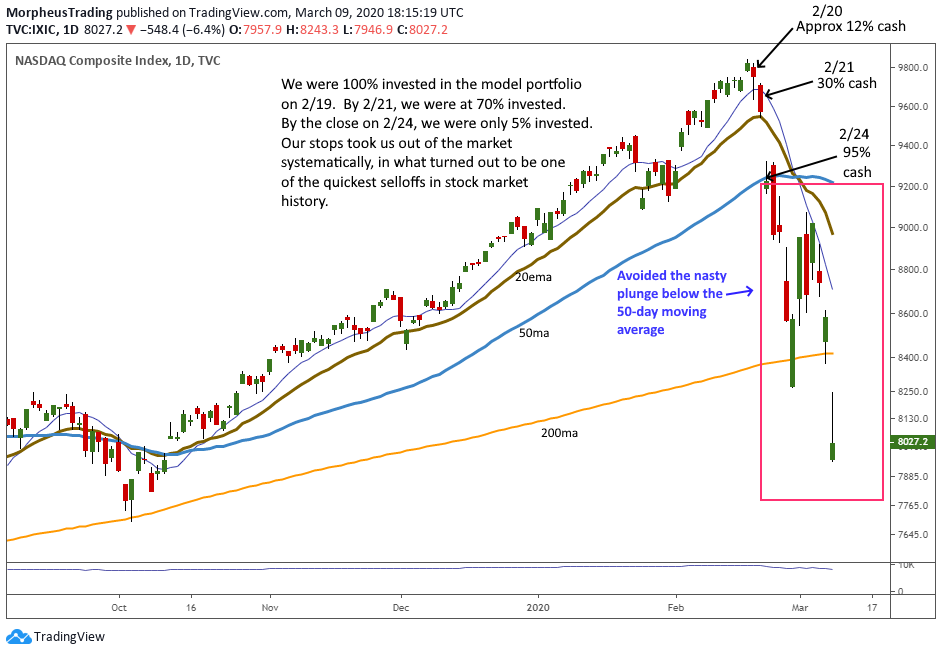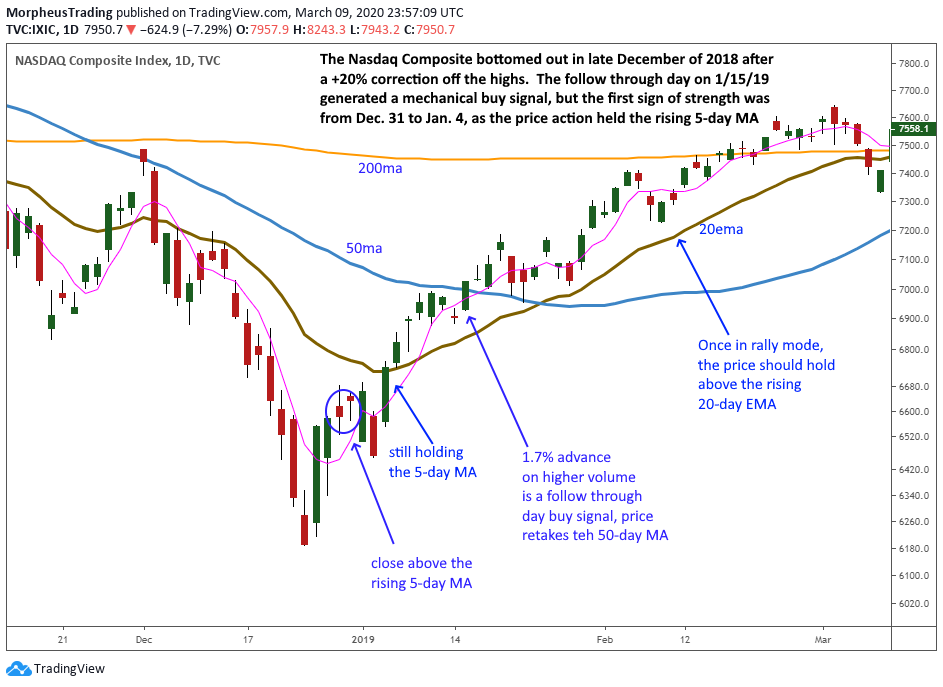
Buying too early during a major stock market correction can have devastating results. Here is a simple and highly reliable way to know when it’s the proper time to jump back into the market, while still keeping risk in check.
The current stock market correction is one of the quickest selloffs in history. Both the benchmark S&P 500 and NASDAQ Composite indices plunged roughly 15% over the past fourteen sessions.
Fortunately, we managed to stay out of harm’s way during this tumultuous decline.
Just prior to the current market sell-off, we held 100% long exposure in the model portfolio of our swing trading newsletter.
By February 21, we were down to 70% long exposure, raising a 30% cash position.
Following the nasty gap down on February 24, our model portfolio was immediately down to just 5% long exposure and 95% cash (find out more about how we managed the start of the sell-off in our previous blog post).
Since then, our subscribers have been appreciatively sitting on the sidelines with a full cash position while the S&P 500 tumbled another 15% lower—and sliced through support of both its 50 and 200-day moving averages.
It wasn’t that we had some genius insight to make us think it is wise to sell all positions, protect recent profits, and shift 100% to cash.
Rather, we were systematically taken out of the stock market via our preset stops, which we had recently raised to protect profits.
Our exits were not perfectly ideal, especially after a 4% gap down on February 24. But we were nevertheless able to quickly minimize our long exposure and exit with some profits during a record-setting market decline:

Given how quickly and intensely overall conditions melted, we were indeed happy with our recent exits.
We have also been quite grateful for GTC stop orders lately, which we religiously set immediately after entering each and every new trade.
In addition to keeping you away from serious harm when a market sharply reverses, stop orders completely eliminate dangerous hesitation and emotion from deciding whether or not to sell a free-falling stock.
With the market now in a nasty downtrend and our model portfolio presently with a full cash position, our subscribers are patiently watching the market for the right signals to jump back in.
But just how will we know when is the right time to start buying stocks again?
Continue reading below to discover a simple and highly reliable method that works time and time again!
The Tried-And-True Follow-Through
Subscribers of our Wagner Daily report know the Morpheus Trading methodology is partially based on William O’Neil’s dependable CANSLIM trading system.
With both the CANSLIM and Morpheus trading strategies, the occurrence of a follow-through day has consistently proven to be one of the most reliable ways to know when to re-enter stocks after a major price correction.
A follow-through day occurs when one of the main stock market indexes gains at least 1.5%, on higher volume, on or after the fourth day of a bullish reversal attempt off the lows.
A real example of a follow-through day can be seen on the annotated daily chart of the NASDAQ Composite below:

Above, notice the follow-through day occurred on January 15, 2019, which was not until Day 14 of the rally off the December 2018 low.
Again, a valid follow-through day must occur on Day 4 or later—not necessarily right on the fourth day. However, you obviously do not want to see the index close below the previous low of the current rally attempt.
Think of the buy signal from a follow-through day as a wake-up call that stocks may be ready to move significantly higher.
Nevertheless, it is not a requirement to wait for a follow-through day before buying quality stocks emerging from solid basing patterns–just don’t go crazy with your overall risk exposure (stay off margin).
As always, the primary question to ask yourself is whether or not bullish chart patterns can still be found right now. If so, are those stocks at or near low-risk entry points?
Many aspects of our trading system, such as the market timing model, are mechanical and rule-based in nature. Still, discretion plays a major role in our overall trading strategy.
Tip: Use the 5-Day Moving Average to Avoid Catching Bottoms
Avoid the urge to catch a market bottom by first requiring a major index to close above a rising 5-day moving average (5-day MA) before taking on new positions.
We recommend having a watchlist of strong stocks ready to go, but wait for one of the major indices to close above a rising 5-day MA. This usually occurs prior to a bullish follow-through day.
After a major index has moved above its rising 5-day MA, monitor its price action closely.
If the price closes back below the 5-day MA, then look for a quick bounce back above it within a day or two.
There should not be significant weakness below the 5-day MA, which would suggest more selling, or at the very least, more chop in the short-term.
Why Size Matters (Especially Now)

When trading in a volatile market trying to find its legs, it is crucial to pay close attention to position sizing–especially if you are new to trading.
As a general rule, newer traders should set stop prices so that the maximum risk of any individual trade is no more than 0.5-1% of account equity.
For example, a beginning trader with a $20,000 account should not lose more than $100 (0.5%) to $200 (1%) on any given trade.
Newer traders should stick with this position sizing guide until they are comfortable executing their system.
But once a certain comfort level is reached through experience, risk can gradually be bumped up to 1-2% of account equity per trade.
Still, this more aggressive risk guideline should only be for perfect trade setups in an unquestionably bullish market.
When the stock market is in correction mode (or even in transition), astute traders reduce their risk by simply decreasing their average position size of new trades until the market generates a fresh new buy signal.
With our Wagner Daily market timing system presently in “SOH” mode (sitting on hands), average size for any new trade in our model portfolio is now reduced to 25%-50% of full position size.
By understanding exactly how much money you should be risking on each trade in ideal market conditions, you can easily trim your risk in a shaky market by reducing your share size to just 1/4 to 1/2 of your normal position size.
Decreasing your capital risk exposure during market corrections and maxing out your maximum dollar risk in overly bullish markets is key to consistent risk management that will keep you in the trading business for the long-term.
Sign up now to receive real-time trade alerts of hot stock picks and educational market analysis in your Wagner Daily subscription.
What do you think of the “follow-through day” concept? What indicators do you use to help you time the market? Share your thoughts below.

beginning trader should follow the rules of trading, after the research they will invest & trade.
A good website. I read them all. I use in conjunction with my other indicators